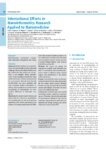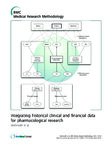1 - 25 of 20
| Creator | Title | Description | Subject | Date | ||
|---|---|---|---|---|---|---|
| 1 |
 |
Warner, Homer R. | Time-Sharing in Biomedical Research | Biomedical Informatics | 1966 | |
| 2 |
 |
Caserta, Michael; Lund, Dale A. | Future directions in adult bereavement research | The primary purpose of this article is to stimulate interest in conducting research related to adult bereavement and provide suggestions for improving the quality of these studies and the application of their findings. Future research needs to generate new knowledge about grief and bereavement but ... | 1998 | |
| 3 |
 |
Warner, Homer R. | Simulation as a Tool for Biological Research | Biomedical Informatics | 1964 | |
| 4 |
 |
Mitchell, Joyce A. | International efforts in nanoinformatics research applied to nanomedicine | Background: Nanomedicine and nanoinformatics are novel disciplines facing substantial challenges. Since nanomedicine involves complex and massive data analysis and management, a new discipline named nanoinformatics is now emerging to provide the vision and the informatics methods and tools needed fo... | 2011-01-01 | |
| 5 |
 |
Mitchell, Joyce A. | Nanoinformatics: a new area of research in nanomedicine | Abstract: Over a decade ago, nanotechnologists began research on applications of nanomaterials for medicine. This research has revealed a wide range of different challenges, as well as many opportunities. Some of these challenges are strongly related to informatics issues, dealing, for instance, wit... | 2012-01-01 | |
| 6 |
 |
Gregory, Joan M.; Mower, Allyson; Youngkin, Mary E.; Le Ber, Jeanne M. | Scholarly research process: from idea to institutional repository. | Steps in the Research Process: 1) Idea generation and refinement. 2) Searching, accessing, reading, evaluating, and keeping track of the literature. 3) Seeking the knowledge/expertise of your colleagues. 4) Designing, seeking approval, and funding for your study, 5) Conducting your study. 6) Recordi... | Scholarly research; Institutional repositories; Dentistry | 2007-01-24 |
| 7 |
 |
Couldwell, William T.; Gillespie, David L.; Jensen, Randy L. | Comparison of the cell lines used in meningoma research | Background: Immortal cell lines and cell lines derived from operative specimens transplanted into animal models are used in meningioma research. We address two criticisms of the mouse xenograft flank tumor model: Why are tumor induction rates derived from operative specimens low and inconsistent? Ar... | CH-157 MN; IOMM-Lee; Meningioma; Xenograft Mouse Model; Flank tumors | 2008 |
| 8 |
 |
Edelman, Linda S. | Dangerous spaces: Using geographic information systems in injury research | PURPOSE: To provide an overview of geographic information systems (GIS) and to discuss current and future applications in injury and trauma research. DESIGN: Literature review and discourse of GIS technology related to injury and trauma research. METHOD: A search of scientific literature databases, ... | Community; Public Health; Technology; Internet; Risk Assessment; Wounds and Injuries | 2007-08 |
| 9 |
 |
Mitchell, Joyce A. | Integrating historical clinical and financial data for pharmacological research | Background: Retrospective research requires longitudinal data, and repositories derived from electronic health records (EHR) can be sources of such data. With Health Information Technology for Economic and Clinical Health (HITECH) Act meaningful use provisions, many institutions are expected to adop... | 2011-01-01 | |
| 10 |
 |
Nebeker, Jonathan R. | pSCANNER: Patient-centered scalable national network for effectiveness research | This article describes the patient-centered Scalable National Network for Effectiveness Research (pSCANNER), which is part of the recently formed PCORnet, a national network composed of learning healthcare systems and patient-powered research networks funded by the Patient Centered Outcomes Research... | 2014-01-01 | |
| 11 |
 |
Mitchell, Joyce A. | 50 Years of informatics research on decision support: what's next | Objectives: To reflect on the history, status, and future trends of decision support in health and biomedical informatics. To highlight the new challenges posed by the complexity and diversity of genomic and clinical domains. To examine the emerging paradigms for sup - porting cost-effective, person... | 2011-01-01 | |
| 12 |
 |
Kestle, John R. W. | Potentially useful outcome measures for clinical research in pediatric neurosurgery | The choice of outcome (or outcomes) and their measurement are critical for a sound clinical trial. Surgeons have traditionally measured simple outcomes such as death, duration of survival, or tumor recurrence but have recently developed more sophisticated measures of the effect of an intervention. M... | Pediatric neurosurgery | 2005 |
| 13 |
 |
Warner, Homer R. | Stepping Down as Editor of Computers and Biomedical Research (Editorial) | Biomedical Informatics | 1993 | |
| 14 |
 |
Mitchell, Joyce A. | Evaluating the informatics for integrating biology and the bedside system for clinical research | Background: Selecting patient cohorts is a critical, iterative, and often time-consuming aspect of studies involving human subjects; informatics tools for helping streamline the process have been identified as important infrastructure components for enabling clinical and translational research. We d... | 2009-01-01 | |
| 15 |
 |
Kestle, John R. W. | Priorities for hydrocephalus research: report from a National Institutes of Health-sponsored workshop | Object. Treatment for hydrocephalus has not advanced appreciably since the advent of cerebrospinal fluid (CSF) shunts more than 50 years ago. Many questions remain that clinical and basic research could address, which in turn could improve therapeutic options. To clarify the main issues facing hydr... | Biomedical research | 2007 |
| 16 |
 |
Narus, Scott P. | A domain analysis model for eIRB systems: addressing the weak link in clinical research informatics | Institutional Review Boards (IRBs) are a critical component of clinical research and can become a significant bottleneck due to the dramatic increase, in both volume and complexity of clinical research. Despite the interest in developing clinical research informatics (CRI) systems and supporting dat... | 2014-01-01 | |
| 17 |
 |
Jensen, Randy Lynn | Treatment-related brain tumor imaging changes: so-called "pseudoprogression" vs. tumor progression: Review and future research opportunities | Background: Glioblastoma multiforme (GBM) has a dismal prognosis despite aggressive therapy. Initial diagnosis and measurement of response to treatment is usually determined by measurement of gadolinium-enhanced tumor volume with magnetic resonance imaging (MRI). Unfortunately, many GBM treatment mo... | 2013-01-01 | |
| 18 |
 |
Dwight, Zachary Lawrence | Laboratory driven, lean-to-adaptive prototyping in Parallel for Web software project identification and application development in health science research | Clinical research laboratories, bioinformatics core facilities, and health science organizations often rely on heavy planning based software development models to propose, build, and distribute software as a consumable product. Projects in non-agile software life cycles tend to have rigid ?plan-desi... | 2012 | |
| 19 |
 |
Mitchell, Joyce A. | Assessing clinical researchers information needs to create responsive portals and tools: my research assistant (MyRA) at the University of Utah: a case study | Question: How can health sciences librarians and biomedical informaticians offer relevant support to Clinical and Translational Science Award (CTSA) personnel? Setting: The Spencer S. Eccles Health Sciences Library and the associate vice president for information technology for the health sciences o... | 2013-01-01 | |
| 20 |
 |
Nebeker, Jonathan R.; Samore, Matthew H | Hypersensitivity cases associated with drug-eluting coronary stents: a review of available cases from the research on adverse drug events and reports (RADAR) project | OBJECTIVES: We undertook the review of all available cases of hypersensitivity reactions after placement of a drug-eluting stent (DES) and classified potential causes. BACKGROUND: Six months after the approval of the first DES, the Food and Drug Administration (FDA) reported 50 hypersensitivity reac... | Drug Hypersensitivity; Coronary Vessels | 2006 |
1 - 25 of 20
